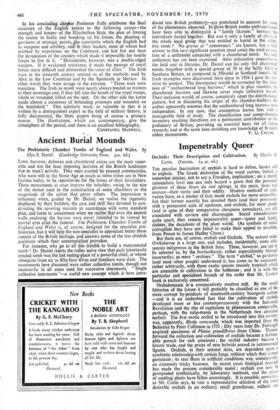• Ancient Burial Mounds
LONG barrows, dolmens and chambered cairns are the most vener- able and not the least imposing features of the British landscape due to man's activity. They were erected by peasant communities, who were still in the Stone Age as much as some tribes are in New Guinea today, to be repositories for the bones of their forefathers. These monuments at once impress the beholder, owing to the size of the stones used in the construction of some chambers or the magnitude of the cairns that goVer 'others The impression is enhanced when, guided by Dr. Daniel, we realise the ingenuity displayed by their builders, the care and skill they devoted to con- structing the covering mounds in accordance with some standard plan, and turns to amazement when we realise that even the neatest walls enclosing the barrow were never intended to be viewed by mortal eyes after the funeral. The Prehistoric Chamber Tombs of England and Wales is, of course, designed for the specialist pre- historian, but it will help the non-specialist to appreciate better these aspects of the British heritage, and answers some of the less childish questions which their contemplation- provokes.
For instance, why go to all this trouble to build a monumental tomb ? Dr. Daniel rejects the rather naive view that each laboriously erected tomb was the last resting-place of a powerful chief, at whose obsequies from six to fifty-four Wives and familiars were slain. The monuments here discussed were rather collective tombs, though not necessarily in all cases used for successive interments. "Single collective interments "—a useful- new concept which is here intro- duced into British prehistory—are postulated to account for some of the phenomena observed. Inliiree-British tombs anthropologists have been able to distinguish a "family likeness" between the individuals buried 'together. But was it only a family of chiefs or the whole local group that was entitled to burial in the collee. tive tomb ? No graves of " commoners " are known, but a final answer to this very significant question must await the total excava- tion of a settlement connected with a chambered tomb. No such settlement has yet been examined. After exhaustive researches in the field and in libraries, Dr. Daniel can list only 165 chambered tombs (together with a special group of 50 in the Scilly Isles) in Southern Britain, as compared to 350-odd in Scotland (nearly lop fresh examples were discovered there since in 1934 I gave the esti- mate he quotes). The discrepancy would be corrected by the inch& sion of " unchambered long barrows," which in plan resemble the chambered barrows and likewise cover single collective burials. Their inclusion would, of course, completely upset the distributional pattern, but in discussing the origin of the chamber-builders the author apparently assumes that the unchambered long barrows were independent. In any case, that assumption leaves him with a manageable field of study. The classification and comprehensive inventory resulting therefrom are a permanent contribution to the prehistory of Britain, providing an essential- basis for all future research, and at tlio_ same time enriching our knowledge of Britain's


















































 Previous page
Previous page